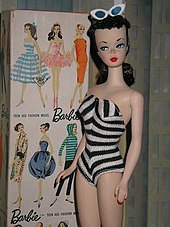History

Ruth Handler watched her daughter Barbara play with paper dolls, and noticed that she often enjoyed giving them adult roles. At the time, most children's toy dolls were representations of infants. Realizing that there could be a gap in the market, Handler suggested the idea of an adult-bodied doll to her husband Elliot, a co-founder of the Mattel toy company. He was unenthusiastic about the idea, as were Mattel's directors.
During a trip to Europe in 1956 with her children Barbara and Kenneth, Ruth Handler came across a German toy doll called Bild Lilli. The adult-figured doll was exactly what Handler had in mind, so she purchased three of them. She gave one to her daughter and took the others back to Mattel. The Lilli doll was based on a popular character appearing in a comic strip drawn by Reinhard Beuthin for the newspaper Bild. Lilli was a blonde bombshell, a working girl who knew what she wanted and was not above using men to get it. The Lilli doll was first sold in Germany in 1955, and although it was initially sold to adults, it became popular with children who enjoyed dressing her up in outfits that were available separately.
Upon her return to the United States, Handler redesigned the doll (with help from engineer Jack Ryan) and the doll was given a new name, Barbie, after Handler's daughter Barbara. The doll made its debut at the American International Toy Fair in New York on March 9, 1959. This date is also used as Barbie's official birthday.
The first Barbie doll wore a black and white zebra striped swimsuit and signature topknot ponytail, and was available as either a blonde or brunette. The doll was marketed as a "Teen-age Fashion Model," with her clothes created by Mattel fashion designer Charlotte Johnson. The first Barbie dolls were manufactured in Japan, with their clothes hand-stitched by Japanese homeworkers. Around 350,000 Barbie dolls were sold during the first year of production.
Louis Marx and Company sued Mattel in March 1961. After licensing Lilli, they claimed that Mattel had “infringed on Greiner & Hausser's patent for Bild-Lilli’s hip joint, and also claimed that Barbie was "a direct take-off and copy" of Bild-Lilli. The company additionally claimed that Mattel "falsely and misleadingly represented itself as having originated the design". Mattel counter-claimed and the case was settled out of court in 1963. In 1964, Mattel bought Greiner & Hausser's copyright and patent rights for the Bild-Lilli doll for $21,600.
Ruth Handler believed that it was important for Barbie to have an adult appearance, and early market research showed that some parents were unhappy about the doll's chest, which had distinct breasts. Barbie's appearance has been changed many times, most notably in 1971 when the doll's eyes were adjusted to look forwards rather than having the demure sideways glance of the original model.
Barbie was one of the first toys to have a marketing strategy based extensively on television advertising, which has been copied widely by other toys. It is estimated that over a billion Barbie dolls have been sold worldwide in over 150 countries, with Mattel claiming that three Barbie dolls are sold every second.
The standard range of Barbie dolls and related accessories are manufactured to approximately 1/6 scale, which is also known as playscale. The standard dolls are approximately 11½ inches tall.
Comments
Post a Comment